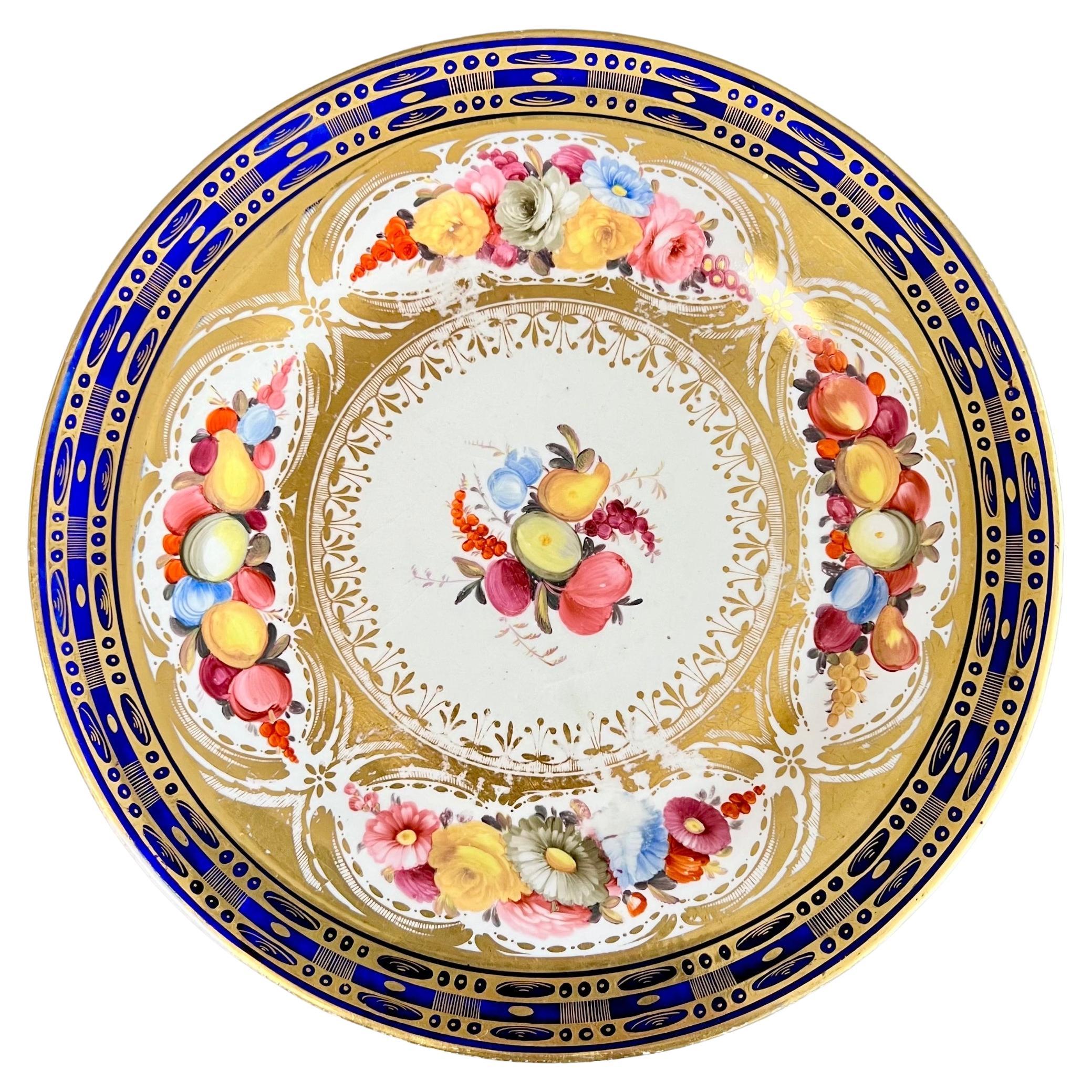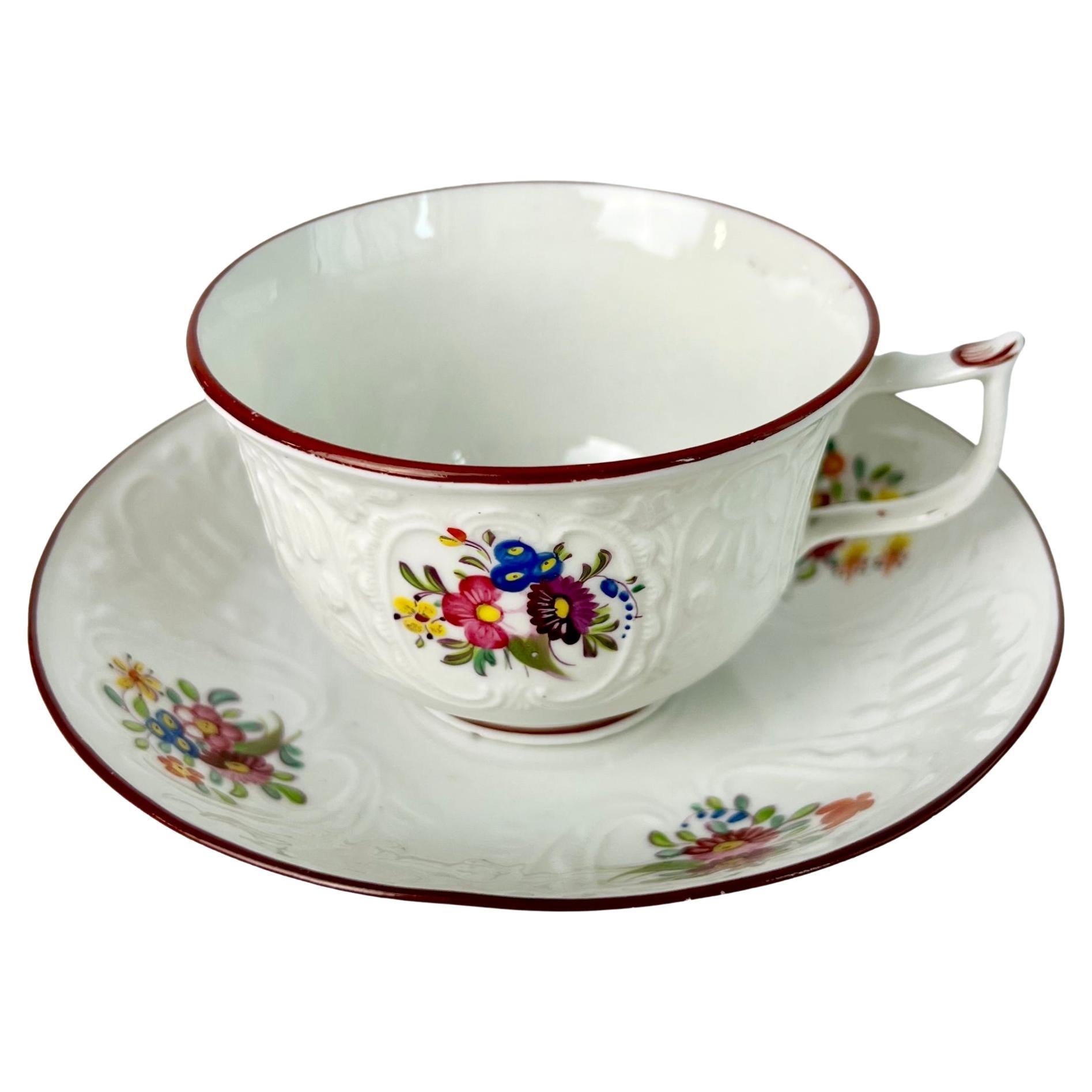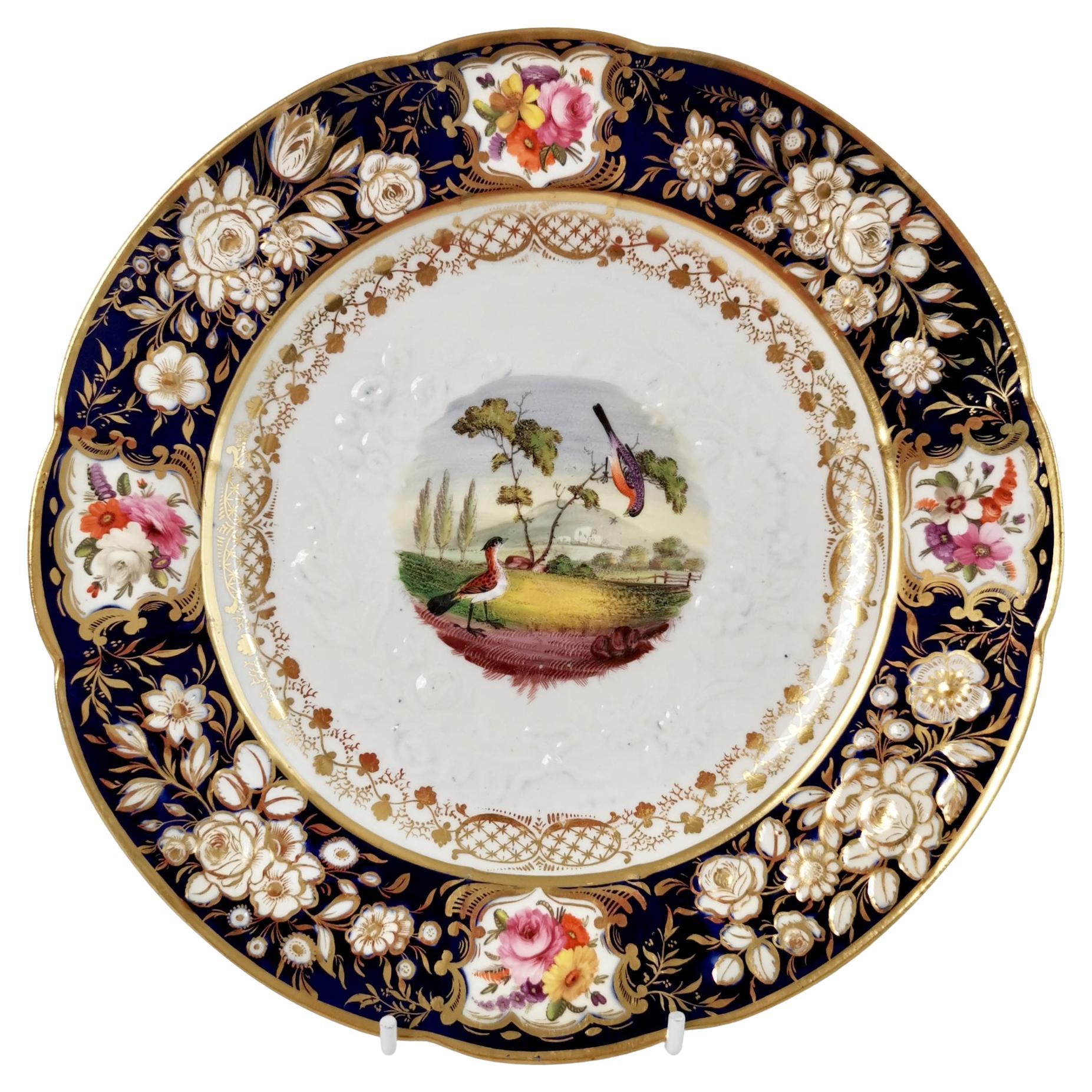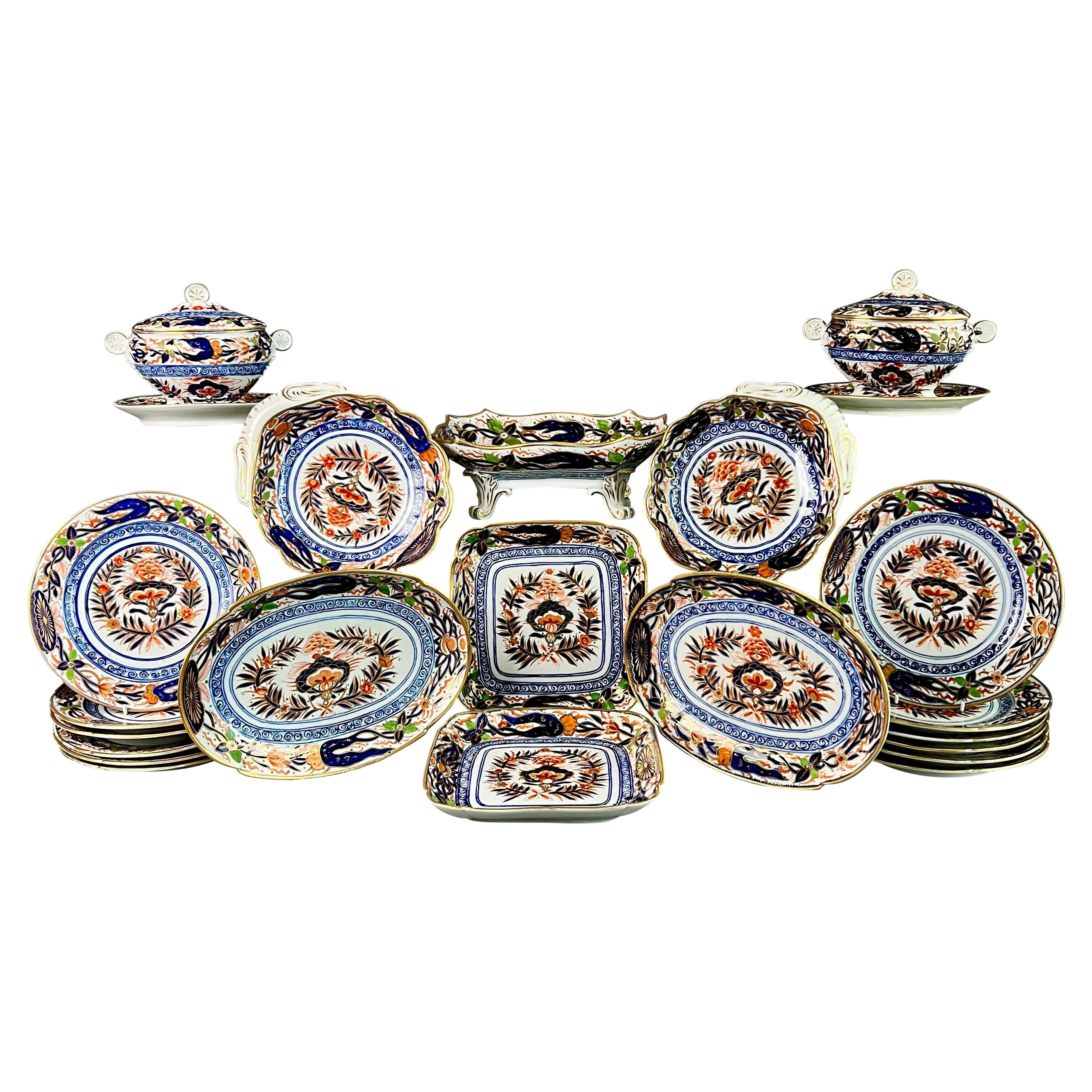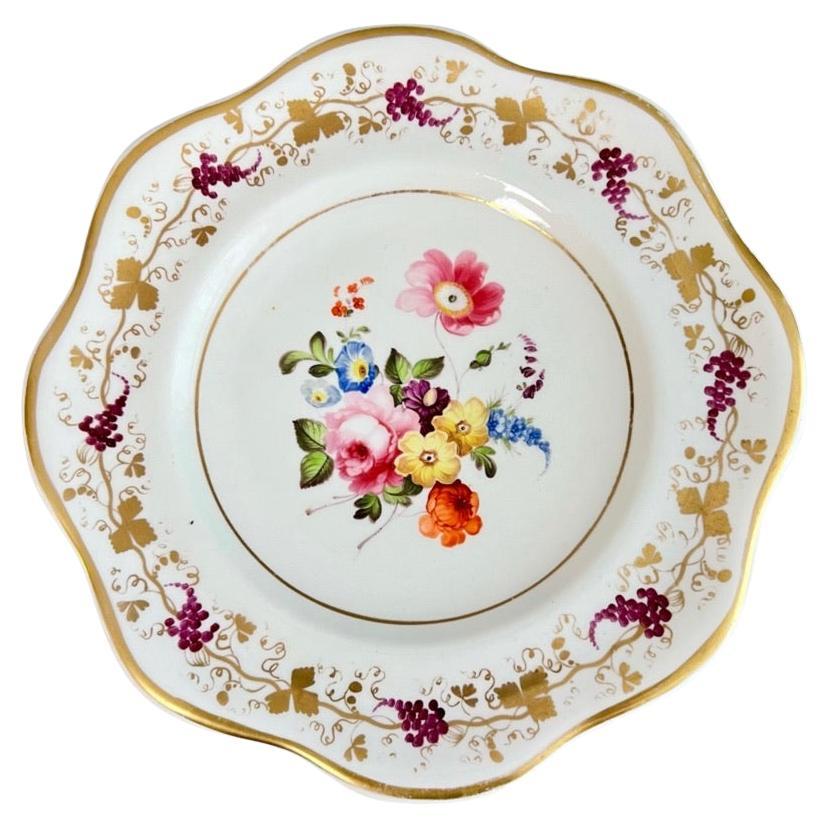Items Similar to Coalport John Rose Porcelain Plate, White Floral Dulong Blind-Moulded circa 1815
Want more images or videos?
Request additional images or videos from the seller
1 of 13
Coalport John Rose Porcelain Plate, White Floral Dulong Blind-Moulded circa 1815
About the Item
This is a beautiful dessert plate made by Coalport in circa 1815.
Coalport was one of the leading potters in 19th and 20th century Staffordshire. They worked alongside other great potters such as Spode, Davenport and Minton, and came out with many innovative designs. When we say "Coalport" we usually think of the one Coalport factory that became famous, but in its beginning years there were two factories, one run by John Rose and the other by his brother Thomas Rose. Thomas Rose went into partnership with Robert Anstice and Robert Horton and they were located directly opposite John Rose, across the canal. The brothers' factories had much in common with each other and they shared many different shapes and patterns. Ultimately, the John Rose factory proved more profitable and John Rose bought Thomas' factory in 1814, making it the one Coalport factory that became so famous. Many of the Coalport items, of either factory, are now collectors' items.
This plate would have belonged to a large dessert service. It was very lightly potted in the famous "Dulong" moulding that was popular between 1805 and 1820. This pattern was an imitation of a famous Meissen pattern from 1743, which was made to the order of Dutch merchants, Godefroy and Dulong, circa 1800 this pattern came to England, where Caughley, Coalport and Grainger Worcester took it up for their porcelains. We know from the fine detail that this is a Coalport version of this beautiful moulding.
The plate is further decorated with slightly naive, cheerful hand painted flowers, and it bears a brown rim rather than gilt - this might mean that it was made for Puritan (Protestant Christian) customers, who would not eat from gilt because of their religious beliefs.
This type of white moulded surface is often called "blind-moulded".
Condition report: The plate is in excellent condition without any structural damage or repairs. It has a few crazing lines in the glaze right next to the flower detail in the centre of the plate and there are a few flakes off the colored flower petals, as visible in the picture. Other than this, the plate is fabulously preserved and it rings well when tapped.
The plate is unmarked, as was common at the time.
Antique British porcelain is never perfect. Kilns were fired on coal in the 1800s, and this meant that china from that period can have some firing specks from flying particles. British makers were also known for their experimentation, and sometimes this resulted in technically imperfect results. Due to the shrinkage in the kiln, items can have small firing lines or develop crazing over time, which should not be seen as damage but as an imperfection of the maker's recipes, probably unknown at the time of making. Items have often been used for many years and can have normal signs of wear, and gilt can have signs of slight disintegration even if never handled. I will reflect any damage, repairs, obvious stress marks, crazing or heavy wear in the item description but some minor scratches, nicks, stains and gilt disintegration can be normal for vintage items and need to be taken into account.
There is widespread confusion on the internet about the difference between chips and nicks, or hairlines and cracks. I will reflect any damage as truthfully as I can, i.e. a nick is a tiny bit of damage smaller than 1mm and a chip is something you can easily see with the eye; a glazing line is a break in the glazing only; hairline is extremely tight and/or superficial and not picked up by the finger; and a crack is obvious both to the eye and the finger.
Dimensions: (diameter) 22.5cm (8.9"), height 2cm (0.75").
- Creator:John Rose (Maker),Coalport Porcelain (Maker)
- Dimensions:Height: 0.75 in (1.91 cm)Diameter: 8.9 in (22.61 cm)
- Style:Regency (Of the Period)
- Materials and Techniques:
- Place of Origin:
- Period:
- Date of Manufacture:circa 1815
- Condition:Wear consistent with age and use. Good condition, some crazing and slight wear but no damage or repairs.
- Seller Location:London, GB
- Reference Number:
About the Seller
5.0
Gold Seller
These expertly vetted sellers are highly rated and consistently exceed customer expectations.
Established in 2016
1stDibs seller since 2019
208 sales on 1stDibs
Typical response time: 1 hour
- ShippingRetrieving quote...Ships From: London, United Kingdom
- Return PolicyA return for this item may be initiated within 14 days of delivery.
More From This SellerView All
- Coalport John Rose Porcelain Plate, Cobalt Blue, Gilt, Flowers & Fruits, 1805-15By Coalport Porcelain, John RoseLocated in London, GBThis is a stunning plate made by John Rose at Coalport between 1805 and 1815. The plate is decorated in underglaze cobalt blue and has beautifully hand painted flowers and fruits, an...Category
Antique 1810s English Regency Dinner Plates
MaterialsPorcelain
- Coalport Teacup, White Blind-Moulded Floral Dulong Pattern, ca 1817By Coalport PorcelainLocated in London, GBThis is a beautiful teacup and saucer made by Coalport in about 1817. The teacup is blind-moulded in the "Dulong" pattern and painted with little floral sprays. We also have a pla...Category
Antique 1810s English Regency Tea Sets
MaterialsPorcelain
- Coalport Porcelain Plate, New Embossed Relief Moulded with Birds, Regency ca1815By Coalport PorcelainLocated in London, GBThis is a very rare and beautiful plate made by Coalport between 1815 and 1820. The plate is relief moulded in the "New Embossed" shape and has a fabulous pattern in cobalt blue, gil...Category
Antique Early 19th Century English Regency Dinner Plates
MaterialsPorcelain
- Coalport John Rose Porcelain Dessert Service, Imari Pattern, ca 1805By Coalport Porcelain, John RoseLocated in London, GBThis is a rather stunning 25-piece dessert service made by John Rose at Coalport around the year 1805. It consists a centre piece on four feet, two oval dishes, two shell dishes, two...Category
Antique Early 1800s English George III Dinner Plates
MaterialsPorcelain
- Coalport John Rose Pearlware Dessert Service, Orange with Silver Vines, ca 1800By Coalport Porcelain, John RoseLocated in London, GBThis is a stunning and extremely rare dessert service made by John Rose at Coalport probably around the year 1800, shortly after Rose bought up the Caughley factory. It consists of a large centre piece comport, one sauce tureen with cover, two oval dishes, two square dishes, two shell dishes, and eight plates. The service is beautifully decorated in the Neoclassical style. Coalport was one of the leading potters in 19th and 20th Century Staffordshire. They worked alongside other great potters such as Spode, Davenport and Minton, and came out with many innovative designs. When we say "Coalport" we usually think of the one Coalport factory that became famous, but in its beginning years there were two factories, one run by John Rose and the other by his brother Thomas Rose. Thomas Rose went into partnership with Robert Anstice and Robert Horton and they were located directly opposite John Rose, across the canal. John Rose had bought up the local Caughley factory in 1799. The brothers' factories had much in common with each other and they shared many different shapes and patterns. Ultimately, the John Rose factory proved more profitable and John Rose bought Thomas' factory in 1814, making it the one Coalport factory that became so famous. Many of the Coalport items, of either factory, are now collectors' items. This service is made of pearlware, which leads us to believe that it might have been made at the old Caughley premises, which had kilns for pearlware - the later Coalport items are not known to be made of pearlware but the shape of the dishes and the sauce comport are clearly a Coalport shape. All items have a beautiful deep orange ground - they were done in different firings as the colour is not entirely consistent, which makes the service very charming. The rims are set off with a beautiful vine pattern in silver, which makes the service even more rare as this was not done often. The items are unmarked, as is usual for that era, except the odd "B", which is probably the gilder's tally mark. CONDITION REPORT The service is in good usable condition with some minor flaws: there is some crazing and wear throughout, which is to be expected of pearlware of this era. The centre piece comport has a slight crack through the side, which is not very visible. One of the plates has a chip on the front of the rim as well as three lines coming off the rim; one has a chip on the underside of the rim; and one has a line coming off the rim. Neither of these stand out and the plates are entirely stable. Antique British china...Category
Antique Early 1800s British Neoclassical Dinner Plates
MaterialsPearlware
- Coalport Porcelain Plate, White with Handpainted Flowers, Regency ca 1820By Coalport PorcelainLocated in London, GBThis is a beautiful plate made by Coalport around the year 1820. The plate is decorated in white with a simple gilt rim, darting puce and gilt vines, and a wonderful hand painted bou...Category
Antique 1820s English Regency Dinner Plates
MaterialsPorcelain
You May Also Like
- Antique Coalport English Porcelain Neoclassical PlateBy Coalport PorcelainLocated in Philadelphia, PAA fine English Neoclassical porcelain plate. By Coalport. Decorated throughout with alternating red and blue geometric patterns, gil...Category
Antique Early 19th Century English Neoclassical Porcelain
MaterialsPorcelain
- English Porcelain Plate, Coalport, circa 1800Located in New York, NYIn the "Dragon in Compartment" pattern.Category
Antique Early 1800s English Dinner Plates
MaterialsPorcelain
- Antique English Neoclassical Porcelain Plate attributed to CoalportBy Coalport PorcelainLocated in Philadelphia, PAA fine antique English Neoclassical porcelain plate Attributed to Coalport. Decorated throughout with rich gilding, and red, green,...Category
Antique Early 19th Century English Neoclassical Porcelain
MaterialsPorcelain
- Pair of 19th Century English Coalport Porcelain PlatesBy Coalport PorcelainLocated in Atlanta, GAPair of large Coalport Porcelain plates with gilt rim and accents, floral decoration in blues, reds, and greens. 19th century England. Price i...Category
Antique 19th Century English Porcelain
MaterialsPorcelain
- Set of 12 Coalport White Shaped Rim Dinner Plates with Handpainted RosesBy Coalport PorcelainLocated in Great Barrington, MAThis set of 12 dinner plates were made by Coalport in 1889 and retailed by Gilman Collamore, New York. Evoking the colors and style of Sevres porcelain, they have shaped rims with mo...Category
Antique 1880s English Dinner Plates
MaterialsPorcelain
- Set of Antique Coalport Porcelain Dinner Plates Depicting English FishBy Coalport PorcelainLocated in London, GBSet of antique coalport porcelain dinner plates depicting English fish. English, late 19th century Dimensions: Height 2cm, diameter 22cm ...Category
Antique Late 19th Century English Porcelain
MaterialsPorcelain
